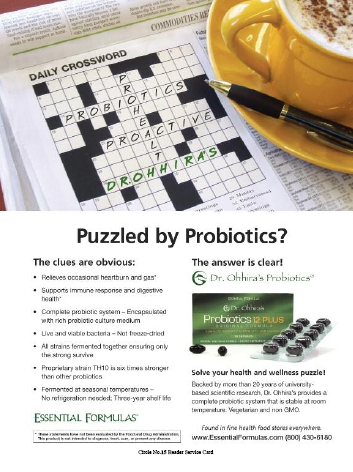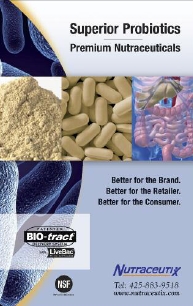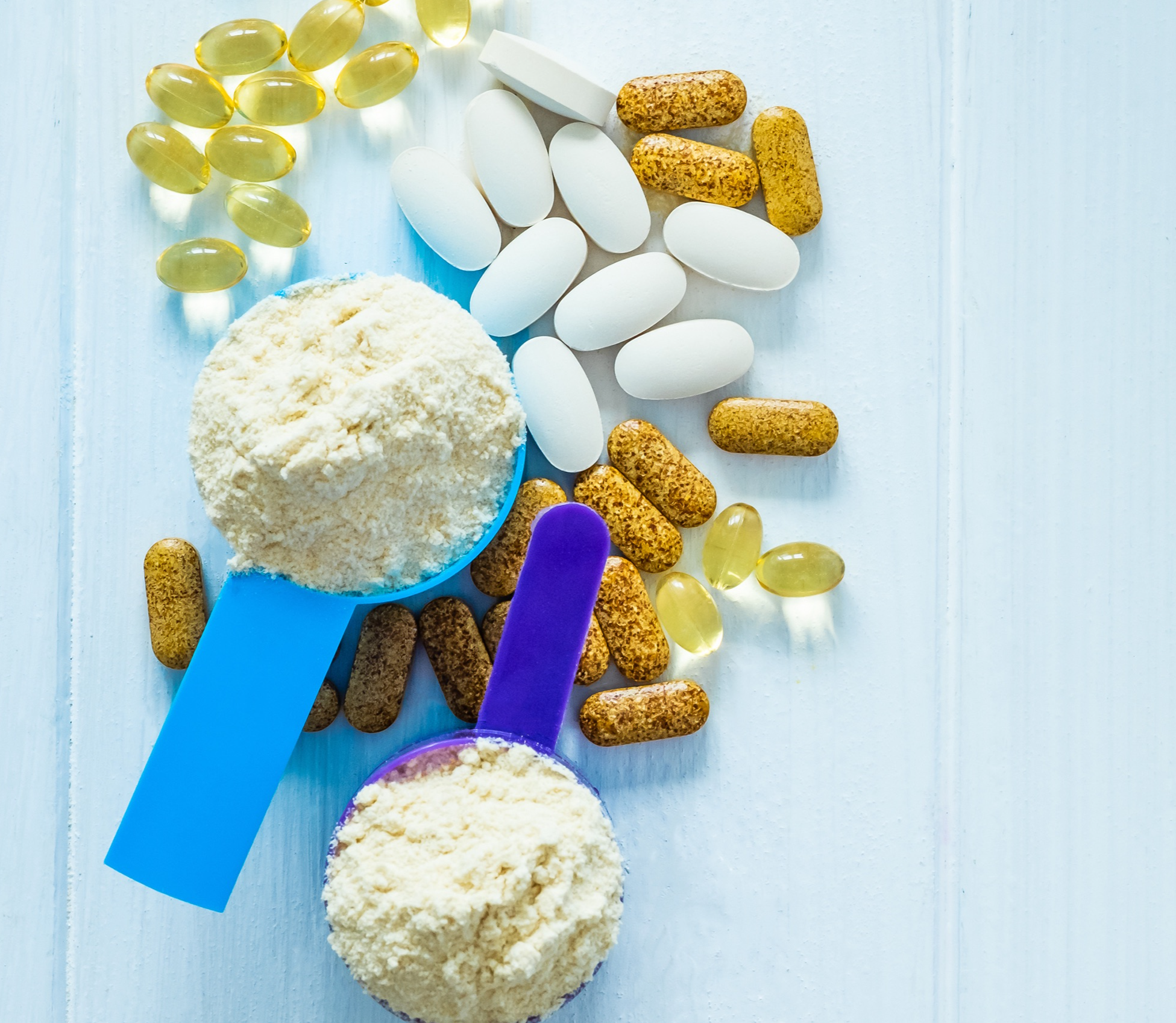Probiotics are making their mark on the natural and mainstream markets, becoming the go-to products for addressing a range of conditions and promoting health. Research has steadily uncovered more crucial information about these friendly bacteria, highlighting digestive health as a gateway to total-body wellness.
Combined Effort As industry has become friendlier with friendly flora, probiotic whole foods combination products have become a hot trend. The benefits and convenience of such products present amazing health opportunities. Jay Levy, director of sales for Wakunaga of America Co., Ltd., Mission Viejo, CA, says, “We have found that probiotics combined with other actives such as fiber, enzymes and probiotics can have a synergistic benefits, such as supporting healthy digestion, regularity and immune function.”
Mixing it up. One avenue of combination products is to include prebiotics along with probiotics. Prebiotics are nondigestible nutrients used by beneficial bacteria that naturally live in the gut, and are sometimes known as fermentable fiber. Fructooligosaccharides (FOS) are a common prebiotic. According to Kate Jones, vice president at Nutrition Now, Vancouver, WA, “FOS has been shown to greatly support probiotic growth in the intestinal tract. Unlike most other carbohydrates and starches, FOS isn’t broken down in the digestive tract and, therefore, it’s highly utilized by the probiotic bacteria.” Other common prebiotic sources are galactooligosaccharides, which are naturally found in human breast milk, and inulin.
 Prebiotics can help get probiotics established in the gut, says S.K. Dash, Ph.D., president of UAS Laboratories, and Connie Falkenstein, R.D., M.S., MPH, director of marketing and education for the Minneapolis, MN-based company.
Prebiotics can help get probiotics established in the gut, says S.K. Dash, Ph.D., president of UAS Laboratories, and Connie Falkenstein, R.D., M.S., MPH, director of marketing and education for the Minneapolis, MN-based company.Tim Gamble, senior vice president at Nutraceutix, Inc., Redmond, WA, affirms, “Certainly probiotics and prebiotics are a promising combination. In fact, one might argue that prebiotics should only be administered with probiotics to avoid the potential for prebiotics to stimulate the uncontested growth of pathogenic bacteria.”
However, the amount of prebiotics needed to be effective may limit the ability of combination products to include both. Jeff Thurston, vice president of Master Supplements, Inc., Victoria, MN, says, “Only so much [prebiotic] can be added to a 500-mg capsule, and some may need three to four grams to be effective.”
Digestive enzymes also are appearing in products with probiotics. These catalytic proteins enhance nutrient absorption by breaking down food particles so they can pass through cell membranes. Common enzymes include protein enzymes such as bromelain and papain; carbohydrate enzymes such as lactase, amylase and cellulose; and fat enzymes such as lipase. Angela Vrablic, Ph.D., nutrition research manager at American Health, Ronkonkoma, NY, says, “Together, they provide multi-level digestive and nutrient absorption benefits through both the stomach (enzymes) and intestinal tract (probiotics).”
Additionally, some manufacturers combine various strains of probiotics into one product because a variety of strains colonize different parts of the gastrointestinal tract. For example, says Vrablic, Lactobacilliusually live in the stomach and small intestine, while Bifidobacteria are typically found in the colon. Thus, she says, it is best to supplement with a combination of strains.
Gamble adds that he has seen success with probiotics combined with vitamins. He says, “The challenge, of course, is keeping the probiotics alive during blending and on the shelf, with so many other ingredients being involved.”
Stability ability.Stabilty is always a concern with probiotics; moisture, heat, oxygen and light are detrimental to probiotic products. But beyond these typical stability issues, combination products portend a new array of challenges. When it comes to combination products, there are some ingredients that may not be compatible with one another. For example, products that contain probiotics and enzymes should be kept especially dry in the manufacturing and packaging process as any moisture may activate the enzymes and destroy the bacteria.
Also, when it comes to products with numerous strains of probiotics, the bacteria may compete with one another, says Michael Shahani, director of operations for Nebraska Cultures, Inc., Walnut Creek, CA, adds, “It is best to not put too many bacteria in one combination. They all compete for the same space and food sources, so a product with many different strains is likely to be less effective than a product with two to four hardy strains delivered in significant doses.”
 For example,L. salivariusmay be somewhat antagonistic toBifidobacteria, says Thurston.
For example,L. salivariusmay be somewhat antagonistic toBifidobacteria, says Thurston.Microencapsulation is one way manufacturers are handling this challenge. Isabelle Champié, global marketing director at Institut Rosell-Lallemand, Montreal, Canada, says, “Many probiotic producers have developed protective technologies, mainly based on the microencapsulation of the dried live bacteria, providing them increased resistance to temperature and pressure environments typical of many industrial process, but also storage and finally gastric acidity.”
Natasha Trenev, founder and president of Westlake Village, CA-based Natren, notes that her company uses sunflower oil for this purpose.
Taking probiotics. When and how probiotics are taken will also affect a product’s end result. To ensure that customers receive the greatest benefit from their products, retailers should also advise customers that combining probiotics with hot foods or liquids could be detrimental to the probiotics’ effectiveness. To this, probiotics can be taken at any time, but may be more effective when taken with a meal (assuming it’s not too hot) or, preferably, after a meal. According to Levy, food dilutes stomach acid and increases the survivability of the probiotics to the intestinal tract. In addition, probiotics aid in breaking down food and assimilating nutrients. “Thus, food enhances the survival and growth of the probiotics, while the good bacteria aids in the digestive process,” he says.
Thurston also advises that supplements like grapefruit seed extract, olive leaf extract and oregano should be separated from probiotics by at least two to three hours because their antimicrobial properties can damage the probiotics.
In addition, the disruption of intestinal function is one of the most common side effects due to the use of antibiotic therapy, as they destroy both good and bad bacteria. Supplementing with probiotic whole foods during and after antibiotic treatment is an easy way to replenish lost intestinal flora and repopulate the good bacteria. This often helps prevent a secondary infection, which is common with antibiotic use, says Levy.
 Mike Bush, vice president of business development at Ganeden, Mayfield Heights, OH, adds, “Of course, antibiotics kill both good and bad bacteria, and therefore decrease the effectiveness of [probiotics]. We suggest remaining on a probiotic even during antibiotic treatment as published papers indicate that strains such as GanedenBC [Bacillus coagulans GBI-30, 6086] support the immune system even though that antibiotic may render it metabolically inactive.”
Mike Bush, vice president of business development at Ganeden, Mayfield Heights, OH, adds, “Of course, antibiotics kill both good and bad bacteria, and therefore decrease the effectiveness of [probiotics]. We suggest remaining on a probiotic even during antibiotic treatment as published papers indicate that strains such as GanedenBC [Bacillus coagulans GBI-30, 6086] support the immune system even though that antibiotic may render it metabolically inactive.”Expanding on Branding Retailers and consumers should also be aware of the issues surrounding probiotic strains that are branded (and those that are not). Lakshmi Prakash, vice president of innovation and business development at Sabinsa Corporation, East Windsor, NJ, notes the importance of properly characterizing probiotic strains. “Branding serves an important purpose because reputable ingredient suppliers have an investment in protecting the integrity of that brand through quality and consistency. Additionally, clinical studies done with a particular properly characterized branded strain would be specific to that brand. Small variations in the genetic profile of strains could induce undesirable characteristics, including virulence potential and antibiotic resistance transfer.”
Additionally, warns Shahani, trials using one strain of a probiotic may only show the efficacy of that strain, not all strains of that genus and species, and commercial probiotics products do not always specify the strain of probiotic. Some strains may have never been scientifically studied, or have been studied but no health benefits have been identified.
Thurston emphasizes the importance of knowing which strain you are getting: “There are hundreds of strains of L. Acidophilus and the genetic difference is far greater than the genetic difference between a human and an elephant. One strain will produce more lactic acid than another, or more acidolphin. So, understanding which strain is used and what was determined as a known efficacy is critical to knowing what you are buying.” Cheap, ineffective organisms are sometimes combined in “proprietary blends,” showing large numbers that sound good in marketing language, he adds. Be sure to stock and recommend probiotics that guarantee specific counts of specific strains at the expiration date on the lot number.
Another important feature of which to be aware is the source of the strain. Levy says, “Human strains are indigenous to the human intestinal tract and according to several specialists in the field of microbiology, human strains are a better choice for supplementation by humans than nonhuman strains. They seem to have better integrity during the manufacturing process, can withstand lower stomach acid pH conditions after oral intake, and have superior stability on shelf.”
Dash and Falkenstein confirm that human isolates are more successful as probiotics than probiotics originating in soil or food.
Trenev of Natren warns that just because a probiotic whole food product is branded doesn’t mean all is okay, emphasizing the importance of thirdparty testing to verify product contents. Trenev notes that although the new good manufacturing practices (GMP) regulations for dietary supplements are stricter, enforcement is lacking, leading some companies, such as Natren, to seek out other certifications (for materials and finished product) such as the coveted Australian TGA certification. Currently, she states, “[U.S.] Government is more concerned about what’s on the label than what’s in the bottle.”
 Adapt to Be Adept Probiotics research charges full steam ahead and has recently uncovered some interesting results related to gene expression and adaptability. Probiotics are not static elements that are introduced to the body, but are, in fact, living, changing organisms.
Adapt to Be Adept Probiotics research charges full steam ahead and has recently uncovered some interesting results related to gene expression and adaptability. Probiotics are not static elements that are introduced to the body, but are, in fact, living, changing organisms.In a recent issue ofISME Journal, it was reported that probiotic bacteria displayed molecular changes, particularly on the cell surface, which impacted gene expression and function of the human intestine (1). The authors asserted that the results identified the “niche-specific adaptations of a dietary microorganism to the intestinal ecosystem and provide novel targets for molecular analysis of microbial–host interactions which affect human health.” Moreover, the authors claim that the form of the probiotic colonizing in intestinal tract may not be the same as the form of the probiotic consumed— the bacteria change/adapt to gastrointestinal conditions.
Silvano Arnoldo, probiotic consultant for Jarrow Formulas, Inc., Los Angeles, CA, explains this communication that exists between the microbiota and the gut: “There are interactions between various bacterial strains and the lining of the gut, which includes the immune system that is found along the lining of the gut. There are specific molecules found on bacterial membranes that turn on specific genes within the intestinal cells. Once it is known which genes are turned on by those specific molecules, and certain molecules have been identified in strains, then administering those specific strains will produce the clinical effects associated with the turning on of those specific genes. This information relates to the specificity of strains and their ability to elicit specific effects on intestinal cells and immune cells.”
Therefore, probiotic formulators need to understand which strains confer a certain kind of response and design probiotic products (strains used) that take into account bacterial adaptation/changes in the intestinal tract. This research is important for choosing the most appropriate probiotic whole foods product and brand formulation.
Flora on a Condition Mission Choosing an appropriate probiotic whole foods product or strain is entirely dependent on the customer, a.k.a., the host. Research is showing that different demographics and people with different conditions may have unique gut microflora and, therefore, may respond differently to probiotic use. Allison Tannis, B.Sc., M.Sc., RHN, nutritional consultant for Enzymatic Therapy, Schwabe North America, Inc., adds, “Similar to how we have fingerprints, we each have our own unique makeup of microbes in our bodies, collectively called our microflora. Environment, diet, stress, age, weight gain and illness are all factors that help affect our microflora. With over 400 different species of probiotics making up your microflora, each offering unique sets of health benefits, there isn’t one particular probiotic that would be most helpful for each person.”
For a quick reference of various condition specific strains, see the online exclusive version of this article for “Condition-Specific Probiotics” on www.wholefoodsmagazineonline. com.
Pregnancy.Probiotics may be especially beneficial during pregnancy. Nutrient absorption is key for pregnant moms, because they are providing nutrition for two. During pregnancy, the baby can disrupt movement of the small and large intestine, possibly causing constipation and intestinal flora imbalance, which can be compounded by stress.
 Probiotics are the first line of defense that a mother offers her child as it passes through the birth canal. Thurston notes that this creates a person’s “probiotic fingerprint,” which can affect their immunity and health for the rest of their life. Babies born naturally have significantly different gut flora than C-section babies, as well as the mother’s status. This explains, in part, why some probiotics work better for one individual over others.
Probiotics are the first line of defense that a mother offers her child as it passes through the birth canal. Thurston notes that this creates a person’s “probiotic fingerprint,” which can affect their immunity and health for the rest of their life. Babies born naturally have significantly different gut flora than C-section babies, as well as the mother’s status. This explains, in part, why some probiotics work better for one individual over others.A 2008 study concluded “probiotics in pregnancy has the potential to influence fetal immune parameters as well as immunomodulatory factors in breast milk” (2).
Shahani says, “Probiotics, especially the DDS-1 strain of L. acidophilus, produce significant amounts of B vitamins and folic acid, essential for pregnant women and their babies. In addition, pregnant women can have diabetes symptoms and digestion problems, both of which can be helped by taking a probiotic supplement.”
Obesity, diabetes.Research is now showing that those who are overweight and have metabolic disorders have different gut microflora than healthy individuals. Recent studies show that people with a variant of the FTO gene associated with obesity have a certain pattern type of microflora in their gastrointestinal tracts, while other research has found a positive correlation between the population of one specific type of bacteria, Bacteroidetes, and body fat percentage in women subjects (aged 40–45 years). “These studies indicate a strong link between genetic makeup, gut microflora, and obesity,” says Prakash.
This is also relevant to excessive weight during pregnancy, which is associated with higher counts of Bacteroides. Furthermore, states Arnoldo, infants who subsequently became overweight or obese, had lower faecal Bifidobatceria count. Obesity is also characterized by some degree of inflammation where the immune system is involved. Given these observations, it is believed that the modification of gut microbiota and immune system modulation may reduce the risk of metabolic disorders such as excessive weight gain during pregnancy and in infants.”
Prakash also notes that bacterial populations of diabetics differ from those of nondiabetics, suggesting a positive role of probiotics and prebiotics in the management of diabetes. Low-grade metabolic inflammation is recognized as an important component of obesity and metabolic syndrome; a healthy microfloral balance can support healthy immune function and the management of inflammation.
Age. As we age, our microflora changes, leading us to be more susceptible to infection and disease. Dash and Falkenstein say, “We know that the gut flora change as we age; children under the age of 10 need more Bifidobacteria and require Lactobacillus as they get older. Seniors have specific issues like constipation that might require higher does of probiotics. They also lose their innate ability to produce digestive enzymes and probiotics that produce digestive enzymes, such as L. acidophilus DDS-1, which can help with these conditions.”
Levy recommends that older people (over 40 years old) should take probiotic whole foods supplements everyday so their intestinal colonies can flourish with beneficial bacteria, providing their bodies with a better-equipped immune systems to fight the growth of disease- causing bacteria.
The Gut Connection The gut’s role isn’t limited to just digestion, but rather is a gateway for other conditions affected by healthy or unhealthy microflora. Probiotic whole foods products are the next logical step to address whole-body health through the digestive system.
Immunity. Approximately 70% of the body’s immune system is located in the digestive tract. Tannis explains, “Probiotics in the digestive tract interact with the immune system and thus affect your entire body’s (systemic) immunity. Nutrients (from your food) as well as toxins (from bad bacteria) from the gut move into the blood stream where they travel throughout the body affecting energy levels and hormone production, ultimately affecting mood, emotion and overall health.”
Falkenstein and Dash say, “L. acidophilus DDS-1 has shown that it increases phagocytic and lymphocytic activity. The organism interacts with cytokine-expressing cells and has demonstrated the ability to induce IL-2, IL-10 and IFN-gamma.”
Skin health.Research has shown the benefits of ingested and topical probiotics for the skin. The skin is a major way for the body to eliminate toxins. Thurston says, “If toxins are being produced in the gut, often they are eliminated through the skin (the largest organ in the body). For many, eczema can be helped with an effective probiotic.”
According to Gamble, “Many skin problems are the result of autoimmune disorders. These disorders seem to have been increasing in recent years, particularly in children.” Many believe this may be due to our overzealous attempt to anti-bacterialize everything. Gamble notes that this elimination of routine contact with good or harmless bacteria has removed a key lesson that our immune systems need in order to distinguish between appropriate and inappropriate responses to environmental stimuli, often resulting in autoimmune disorders and related problems. “Without both good and bad bacteria to learn from, our immune systems become confused and react to harmless factors, creating skin problems, among other conditions,” he says.
This is particularly relevant to allergic reactions. Levy says, “Good bacteria create a barrier against a variety of different types of harmful substances such as bad bacteria, pollutants, free radicals and allergens. It is perhaps the barrier against allergens that gives probiotics the power with skin problems. Eczema, especially in infants, is often the result of a food allergy.” Regular probiotic supplementation can help to keep inflammation in check and can be beneficial for those suffering from eczema, rosacea, canker sores, adult acne, skin rashes or even dandruff.
The issue is still up in the air, however, as some studies have found that probiotics don’t help with certain skin conditions (3).
Condition-specific ProbioticsKate Jones, vice president at Nutrition Now, Vancouver, WA, offers some head-to-head comparisons of different probiotic strains shown to have high efficacy in benefiting these specific conditions:LactobacillusL. reuteri- intestinal or respiratory infections in infantsL. rhamnosus GG- Immune enhancement, infectious diarrhea in children, primary prevention of atopic dermatitis L. casei DN114-001- Immune enhancement L. acidophilus NCFM- Symptoms of lactose intolerance, reduced small-bowel bacterial overgrowth L. plantarum 299V- IBS, post-surgical gut nutrition Lactobacillus casei Shirota YIT9029- Superficial bladder-cancer recurrence, intestinal microbiota, immune enhancement BifidobacteriumB. infantis- irritable bowel syndromeB. lactis BB-12- Immune enhancement, diarrhea in children B. longum BB536- Allergy symptoms, intestinal micro-ecology B. lactis HN019 (DR10)- Immune enhancement, especially in elderly B. animalis DN173-010- Normalizes intestinal transit time |
Mood/mental health. The idea of a brain–gut axis is not a new concept, but the idea of looking at the role of intestinal microflora with the addition of probiotics in this brain-gut conversation is a more novel concept, indicating promising applications for probiotics in mental health and the management of stress and anxiety.
A recent study (4) looked at the effects of a branded probiotic preparation (Probio’- Stick from Institut Rosell-Lallemand) on rats’ behavioral signs of depression two weeks following the induction of myocardial infarction (MI). While rats on the control diet showed behavioral signs of depression, the probiotic treatment was able to significantly reduce these signs. The probiotics also prevented the post-MI increase of pro-inflammatory cytokine IL-1b, which is one of the mechanisms involved in the onset of post-MI depression via induction of apoptosis, or programmed cell death, in certain parts of the brain. The study also showed that myocardial infarction has a damaging effect on the intestinal barrier, but that the probiotic was able to restore its integrity.
In addition, the branded probiotic product was shown to significantly reduce gastrointestinal symptoms associated with stress in a double-blind, placebo-controlled randomized trial on healthy volunteers subject to chronic stress (5). Champié notes, “Altogether, these exciting findings lead the way to promising applications in mood and depression management. Probiotics have a track-record of safe long-term use, without the side-effects and habituation issues often associated with pharmacological treatments.”
Emotions and mood may also have much to do with one of the most prevalent digestive conditions in America today, irritable bowel syndrome (IBS). IBS can cause cramping, abdominal pain, bloating gas, diarrhea and constipation, often made worse by stress, although no exact cause is known as of yet. According to Arnoldo, more than 80% of total body serotonin is located in the GI tract and is involved in brain-gut signaling. He says, “There is a network of neurons within the intestinal tract that is connected to the central nervous system. There is increasing evidence that there is communication between the intestinal tract and the nervous system. This is relevant to IBS. In addition to intestinal symptoms, many IBS patients experience depression and anxiety. A disturbed brain-gut signaling is associated with some of the IBS symptoms.” Prakash adds, “Gastric discomfort, inflammation and bloating affect mood and behavior, so maintaining a healthy balance of microflora therefore helps improve patterns of mood and behavior as well.”
More on IBS will appear in the October issue of WholeFoods. WF
References
1. M.L. Marco, et al., “Convergence in Probiotic Lactobacillus Gut-Adaptive Responses in Humans and Mice” ISME J., published online May 27, 2010. 2. S.L. Prescott, et al., “Supplementation with Lactobacillus rhamnosus or Bifidobacterium lactis Probiotics in Pregnancy Increases Cord Blood Interferon-g and Breast Milk Transforming Growth Factor-g and Immunoglobin A Detection,” Clin. And Exper. Allergy 38 (10) 1606–1614, 2008. 3. R. Gøbel, et al., “Probiotics to Young Children with Atopic Dermatitis: A Randomized Placebo-Controlled Trial,”International Journal of Probiotics and Prebiotics 5 (2), 53–60, 2010. 4. S.A. Girard, et al., “Lactobacillus helveticus and Bifidobacterium longum Taken in Combination Reduce the Apoptosis Propensity in the Limbic System after Myocardial Infarction in a Rat Model,” Br J Nutr. 29:1–6, 2009. 5. L. Diop, et al., “Probiotic Food Supplement Reduces Stress-Induced Gastrointestinal Symptoms in Volunteers: A Double-Blind, Placebo-Controlled, Randomized Trial,” Nutrition Research 28 (1), 1–5, 2008.
Published in WholeFoods Magazine, September 2010.
This editorial series is sponsored by Essential Formulas and Nutraceutix.









